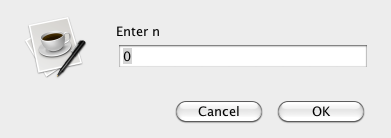You can use the JOptionPane class.
String input = JOptionPane.showInputDialog("Enter n", "0");
The first argument is the prompt. The second is the default value. Note
that it returns a String. When executed, the code above displays the following window.
Look at the
getScanner method from the ClassScores classwork assignment.
Use repeated division by
10 or use the Math.log10 method.
Use repeated division by 10
again, followed by the modulo operator to pick out just the rightmost
digit or use the Math.pow method.
You can check to see if two strings are equal using the
.equals method. For example,
if some String token is equal to (*, then
token.equals("(*") will evaluate to
true.